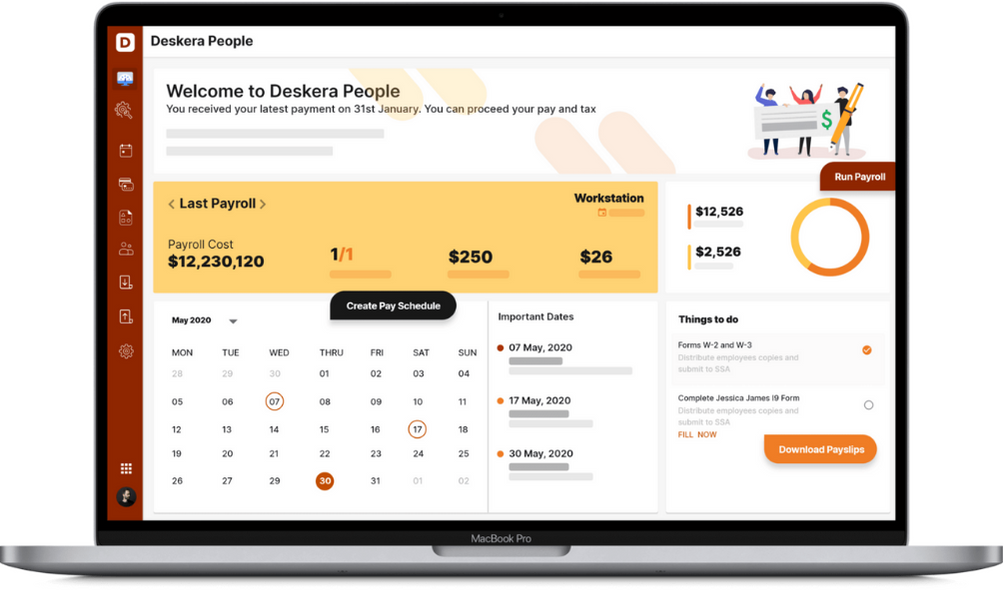Do you know that the number of businesses established in the United States has reached the level of over 32.5 million in total?
The foundation of building your business makes you through the preparation and a robust chart process to let your business survive and thrive, especially in the United States.
Starting a business involves:
- Planning
- Designing the structure
- Completing the legal formalities
- Building the identity
- Digital presence
- There are many more actionable steps to create a competitive advantage among the other businesses
This article has covered a comprehensive step-by-step guide on commencing your business in the United States. We have also dug deeper to bring the insights and tips for a business owner to start operating a successful and profitable business.
9-Step Guide to Start a Business in the United States
As a business owner, your first step starts with planning; then it moves towards making financial decisions and finally completing a series of steps to start your business.
Following is the 9-step guide to starting a business in the United States!
- Identify ideas and conduct business research
- Curate the Business Plan
- Pick a suitable business structure and choose a name for business
- Check the legal formalities
- Create brand identity
- Get clear with operations like Accounting, Insurance, Location
- Open the Bank Account and Fund your business
- Collaborate with partners, vendors, and team
- Launch and grow your business
Let's scroll down to understand each and every single step:
1. Identify ideas and conduct business research
The first step by starting your business is to consider your strengths, weaknesses, and interests that will help you to focus on a single idea.
With lots of ideas being generated in the market, you just need to answer a fundamental question as
Why do you want to start this business?
Or
What idea or purpose do you want to serve through this business?
Once you get the answer, you will focus on a single idea that will turn into a business opportunity.
The next thing you need to do is conduct market research to understand the target market and demographics of the targeted customers.
It involves processes to understand the competition and the kind of products and services offered. You can gather information and use it to find a competitive advantage for your business.
2. Curate the Business Plan
After generating the business idea and conducting market research, the next step is to create a business plan that will help to crystalize ideas and provide a roadmap as to how to structure, operate and grow your business.
An investor or a partner will be interested in a business only if you have a solid business plan to showcase in front of them.
Hence, it is a crucial step such that you can shape your business well. As far as the curation of business plans are concerned, business owners can look forward to creating a traditional business plan or a more compact business plan based on the idea or business model. You can easily create your business plan with the help of a business plan writer or an AI business plan generator.
A typical business plan should be created as a comprehensive guide that includes the executive summary, elevator pitch, and specific business plan sections.
It is also considered the first impression that will convince others to invest in your business or excite others to do business with you.
3. Pick a suitable business structure and choose a name for the business
Once the business owner has selected the business idea and curator business plan, the next important step is to decide on the legal structure of your business identity.
As per the US federation, you can operate your business as a
- Sole proprietorship
- Limited liability company
- Corporation
- Partnership
- Small Business
Though these are different forms of businesses, the legal structures of all these businesses are entirely different.
From filing taxes to the tax treatment of revenues and expenses, personal liabilities, and legal compliances, the procedures and requirements are different at the local, state, and national levels.
So before you select the business type, make sure to assess the legal structures available to you and then select the suitable option based on a business idea.
Next, coming down to choosing the business name, it is not easy to pick the perfect name.
The main reason is that you cannot pick up a business name already used by someone else. Hence, you should pick a name that will reflect your brand and capture the spirit of your business identity.
4. Check the legal formalities
When starting a business in the United States, you need to be extremely careful in complying with legal issues to minimize risk and prepare for what's going ahead.
Understanding and checking the legal formalities is the most critical step of setting out your business that covers the following:
a.Hire a business lawyer
b. Request for federal and state tax IDs
c. Register your business
Hire a business lawyer
Since business owners need to comply with many legal formalities, it may sound intimidating to handle all by themselves. Therefore, it is recommended to hire a reasonably priced and competent business lawyer who will assist you in completing the legalities and give advice that can build your business.
Request for federal and state tax IDs
Under the legal formalities section, the next step is to register and get an Employer Identification Number (EIN) from the IRS to pay the federal and state taxes. In addition, you also need to pay sales tax to the state government or the local municipalities.
Register your business
The next step involves registering the business with the US government. It means that a business is operated under the law and has a separate legal existence.
In addition, there are specific licenses and permits like business licenses, state licenses, county permits data required for certain types of businesses.
You need to apply for these licenses and permits separately.
5. Create a brand identity
Brand identity adds up to the company's value that describes you, your customers, your connections, and the prospective customers that they hold towards you.
Brand identity helps to build loyalty and makes it easier for you to acquire new customers on board.
Creating brand identity can be divided into two parts:
- Brand logo creation
- Building website and online presence
A brand logo is considered the face of the brand.
While creating a brand logo, every business owner has their take in presenting the logo with all the necessary elements to reflect the brand. In addition, the breakdown of logo in conveying the meaning and message of the brand is of utmost importance.
Building website and online presence
Like the brand logo, your business website is the most important component and base to create marketing and branding strategies. Research claims that 97% of the consumers in the United States purchase online by a company website and hence, the presence of the website becomes vital for a business owner.
A business owner can maximize its potential by showcasing its brand online by building an online presence. The COVID-19 pandemic brought an evolution in working on operating the business via online mediums.
Hence, by building a credible online presence, you can be full of opportunities, build trust among the customers, and generate lots of leads for your business.
6. Get clear with operations like Accounting, Insurance, Location
After you have planned out the creation of brand identity, the next step involves assessing important operations like Accounting, Insurance, and Location to create a solid and profitable business. All of these operations play a crucial part in maintaining the business systems critical for the long-term longevity of the business.
Let's discuss each of the operations in brief:
Setting up accounting and bookkeeping
In order to manage your finances and cash flow activities, the business needs to set up a bookkeeping and accounting system. It will help them to systematically analyze the financial position and also help keep track of income, expenses, profit, and loss
Picking up the business location
Picking up the best suitable business location is not easy as it sounds. Your business location should cover the customers' and employees' demographics that will bring them to your place. In addition, you also need to assess the accessibility of parking, public transport, timings, and foot traffic.
Purchasing business insurance
A business is full of risk, and this is why business owners should protect themselves and their businesses from any unforeseen situations that may happen in the future.
Business owners should purchase business insurance right from the start to secure themselves from any kind of claims against them or their businesses.
7. Open the Bank Account and Fund your business
After running through the operations, the next step is to open a bank account with a strong banking partner that can take you along all the banking functions in one place.
It is recommended that the business owner keep a check and learn about opening the business bank account with respective banks and compare their prices, interest rates, and maintaining procedures.
As far as the funding part is concerned, no business owner can fund the entire business by themselves. They need assistance through
- Loans provided by banking and financial institutions
- Crowdfunding
- Investors who are likely to invest in the business and much more
With multiple options to fund your business, it is important to understand the pros and cons of each option and then pick up the best one based on your business.
8. Collaborate with partners, vendors, and team
When you create a business, it is not just about you; it is also about the people who are going to associate with you.
As a business owner, you can't do everything on your own, and hence, you need assistance from your community to go a long way!
This is the reason why a business owner should collaborate with
- Partners who will help you sustain for the long term.
- Vendors who will help you sail through in your journey and assist you in providing the resources and materials to grow your business.
- Teams who will carry out the business functions and scale your business to heights
They are often regarded as the pillar of strength in making the business stand above the competition.
9. Launch and grow your business
After completing all the eight steps, from identifying the business idea to finally collaborating with the community, you are about to hit the fortune of fulfilling your dream to start the business.
It's your time to push the launch button of your business and promote it to your potential customers and target audience.
Create an effective sales plan and get set ready to create the masterpiece of consistency backed by a solid team standing behind your business.
It's your time to build the customer base and promote your business by implementing branding and marketing strategies!
Take baby steps and embrace every procedure in building the businesses of tomorrow!
How Can Deskera Assist You?
As a business, you must be diligent with employee leave management. Deskera People allows you to conveniently manage leave, attendance, payroll, and other expenses. Generating payslips for your employees is now easy as the platform also digitizes and automates HR processes.

Bottom Line
Building your own business from the ground up is an exciting and challenging opportunity at the same time.
You are all set to cut the big ribbon and launch your business by following these actionable steps!
Remember that it is just the start!
You have a long way to go in managing and growing the business by handling multiple tasks simultaneously, adapting to the changes in the environment, preparing yourself for unforeseen situations, understanding the customers, solving the problems, and leading your team; in the best way!
Key Takeaways
The foundation of building the business leads you towards the process that makes your business survive and thrive!
This article covered a step-by-step guide to convert your dream of owning the business into reality and presented the set of actions that you need to undergo to operate a successful and profitable business in the United States.
Following are the key takeaways of the article:
- The step-by-step guide to starting a business in the USA begins with identifying the idea and conducting the business research, making financial decisions, and finally completing a series of steps.
- The first step is to identify the idea that will turn into a business opportunity and conduct market research to understand target customers' target market and demographics.
- The second step is to create a business plan that will help to crystallize ideas and provide a roadmap to structure, operate and grow the business.
- The third step is to pick a suitable business structure like a sole proprietorship, limited liability company, Corporation, partnership for small business. It also involves choosing the name of the business.
- The fourth step involves checking the legal formalities and complying with the legal procedures in operating your business.
- The fifth step is to create a brand identity that will add to the company's value. It involves making the brand logo and building the website and online presence.
- The sixth step involves the business owner getting the clearance with the operations like accounting, insurance, and location.
- The seven-step is to open a bank account to carry out banking functions in one place. The business owner must arrange funds through loans, crowdfunding, or pitch directly to the investors.
- The eighth step involves the people who are going to associate with the business owner, like partners, vendors, and teams.
- Finally, after completing all eight steps, you are all set to hit the fortune in fulfilling your dream to start your business.
- It's your time to push the launch button of your business.
Related Articles












